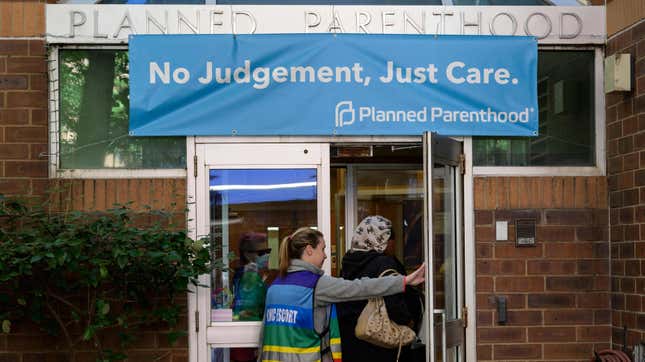After Roe Fell, Uneven Access to Abortion Created a ‘Complete Disruption in Healthcare’
New data shows that abortion numbers increased in the year after Dobbs overturned Roe v. Wade and upended abortion access across the country.
AbortionPolitics

The first year following the Supreme Court’s reversal of Roe v. Wade upended abortion access but still led to an increase in abortions, according to one researcher who studied the number of abortions that happened since the nation’s highest court stepped in. “What actually happened during these 12 months is that abortion access plummeted to zero in some states, while increasing to meet the acute need in others, leading to a complete disruption in the healthcare system and people’s lives,” Dr. Jenny O’Donnell, senior director of research and evaluation at the Society of Family Planning, told reporters on Tuesday.
On average across the U.S., there were more than 2,200 more abortions each month compared to before and after the Supreme Court’s Dobbs v. Jackson Women’s Health Organization decision that overturned Roe, according to the Society of Family Planning’s #WeCount national abortion reporting effort released on Tuesday.
While abortions went up, the researchers emphasized that where abortions increased is the most important. The researchers refer to Illinois, Florida, North Carolina, California, and New Mexico, as “surge states” because they saw a escalation of patients after Dobbs. “What we call surge states [are] border states with abortion bans and serve as access points for people who travel from other states to get care. These experiences of travel are often arduous, expensive, and can be traumatic for the people involved,” O’Donnell said.
Out-of-state patients probably don’t account for all the increases in states with expanded access to abortion. “In many surge states, help systems and support networks have needed to expand to meet to meet these increased needs [of traveling patients], through improved policies on abortion access, funding for travel, the rise in tele-health abortion, and in some cases, new abortion facilities,” O’Donnell said.
Though the number of abortions increased in the year after Dobbs, abortion access is still decimated and out of reach for many. In the 14 states with total abortion bans, there were 94,930 fewer clinician-provided abortions from July 2022 to June 2023. “That’s a decrease of nearly 100 percent in the number of abortions compared with the pre-Dobbs months,” Dr. Alison Norris, #WeCount co-chair and professor at The Ohio State University’s College of Public Health, told reporters on Tuesday.
In states with six-week abortion bans, there were 19,660 fewer abortions provided. Georgia, whose state Supreme Court just ruled on Tuesday to keep its its six-week ban in place, had a 50 percent decrease in abortions after the Dobbs decision.
“We Count can’t tell us what’s happening to those 115,000 people. We can assume that some of these people traveled to other states for care,” Norris said. “The surge that We Count sees in states that are proximate to states with abortion bans indicates that many people are traveling for abortion care.”
Virtual-only clinics providing abortions have only increased in the year post-Dobbs. There are now an average of almost 7,000 abortions each month from these virtual clinics. We Count doesn’t count self-managed abortions and others outside the medical system.
Amber Gavin, vice president of advocacy and operations at independent abortion provider A Woman’s Choice, told reporters on Tuesday that the surge of out-of-state patients led to their North Carolina and Florida clinics treating patients from as far away as Texas. “She talked about this decision with her doctor who temporarily took her off blood thinners so she could get the care she wanted and needed. She drove 16 hours from Texas to our Greensboro, North Carolina clinic, and 16 hours back after she received her care,” Gavin told reporters.
This summer North Carolina banned abortion at 12 weeks, and Florida is awaiting a Supreme Court decision that could mean banning abortion at 6 weeks. As I’ve previously written, the South is being squeezed dry of abortion access. If North Carolina and Florida are no longer able to provide abortion care beyond six weeks, the next closest clinics are in Illinois, Kansas, New Mexico, Ohio, and Virginia. If you’re in southern Florida, Puerto Rico might be your best option for in-person care.
“If the Florida six-week ban goes into effect, I’m truly not sure where the thousands of people across the southeast who need abortion care after six weeks will turn to as many of our abortion clinics are at capacity, and it could take weeks for folks to get an appointment,” Gavin said. “I think it’s unconscionable to take away essential health care from our communities, to take away their choices and options. I’m fearful and sad about folks not having access to this essential care and being stripped of their ability to make decisions that are best for their lives, their families and their futures.”